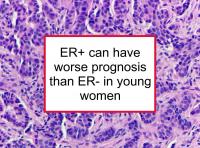Hormone receptor positive breast cancer, which has both estrogen receptor positive (ER+) and progesterone receptor positive (PR+) tumor receptor status, is considered to have more favorable prognosis than other ER/PR subtypes (ER+/PR-, ER-/PR+, or ER-/PR-). This is partly because ER+/PR+ disease tends to be comparatively indolent.
In addition, more treatment options are available for ER+/PR+ breast cancer. However, ER+/PR+ disease does have has some unfavorable characteristics. For example, by five to seven years after diagnosis, it is more likely to recur than other subtypes. In fact, ER+/PR+ breast cancer can recur decades later. ER+/PR+ disease also appears to have more unfavorable outcomes in young women compared to older women. Now a new study has reported that ER+ status is not a favorable prognostic factor compared to ER- status among women diagnosed with breast cancer before age 40.
Luminal B breast cancer has worse outlook than luminal A
Luminal A and luminal B are molecular phenotypes determined by breast cancer gene expression profiling. Part of the explanation for the relatively poor prognosis of ER+ disease in young women is that it is often luminal B whereas postmenopausal women typically have luminal A disease. Luminal A is normally strongly ER+ and PR+ and not HER2-positive (HER2+), with low tumor grade and low proliferation (Ki-67 < 15%). ER+/PR+/HER2- tumors are normally luminal A.
Luminal B disease is characterized by weak to moderate ER+/PR+ and can be HER2- or HER2+. Luminal B breast cancer may have low tumor grade, but tends to have higher proliferation and DNA instability than luminal A. ER+/PR- and ER-/PR+ tumors are normally luminal B.
ER+ status is not favorable prognostic factor in young women
The study referenced at the beginning of this news story was designed to assess the prognostic impact of ER status depending on age at diagnosis. The study included 1,910 women with primary stage I to stage III breast cancer who were treated at Women’s College Hospital, Toronto, during the period 1987 to 2000. The women were followed from diagnosis to the end of the follow-up period or until death. Statistical methods were used to estimate the 15-year rates of breast cancer-specific survival for women with ER+ and ER- breast cancer. A total of 1,347 (70.5%) of the participants had ER+ disease whereas 563 (29.5%) had ER- breast cancer; 213 of the participants were under age 40 at diagnosis whereas 1,697 were diagnosed between ages 40 and 75.
Without taking age into account, the estimated 15-year breast cancer-specific survival rate was estimated at 77% for women with ER+ disease compared to 70% for those with ER- breast cancer. However, the prognostic impact of ER status was found to vary based on age at diagnosis. The 15-year breast cancer-specific survival was found to be worse for those with ER+ disease (55%) compared to those with ER- disease (61%) among women diagnosed before age 40. On the other hand, the 15-year breast cancer-specific survival was found to be superior for those with ER+ breast cancer (78%) compared to ER- breast cancer (72%) among the women diagnosed between ages 40 and 75.
The authors conclude that ER+ status is not a favorable prognostic factor among women diagnosed with breast cancer before age 40.
Please see our article on breast cancer in young women for more information.
